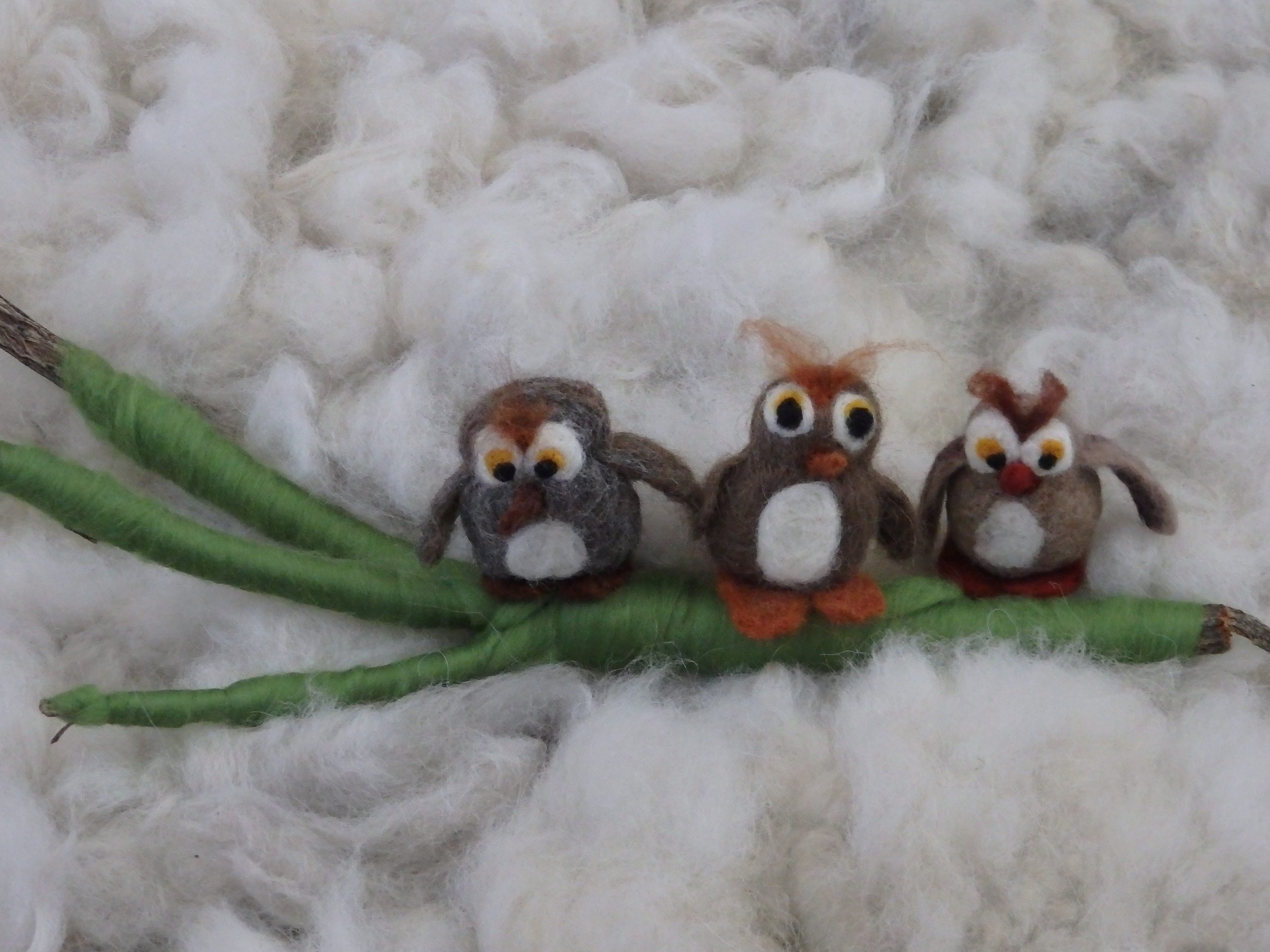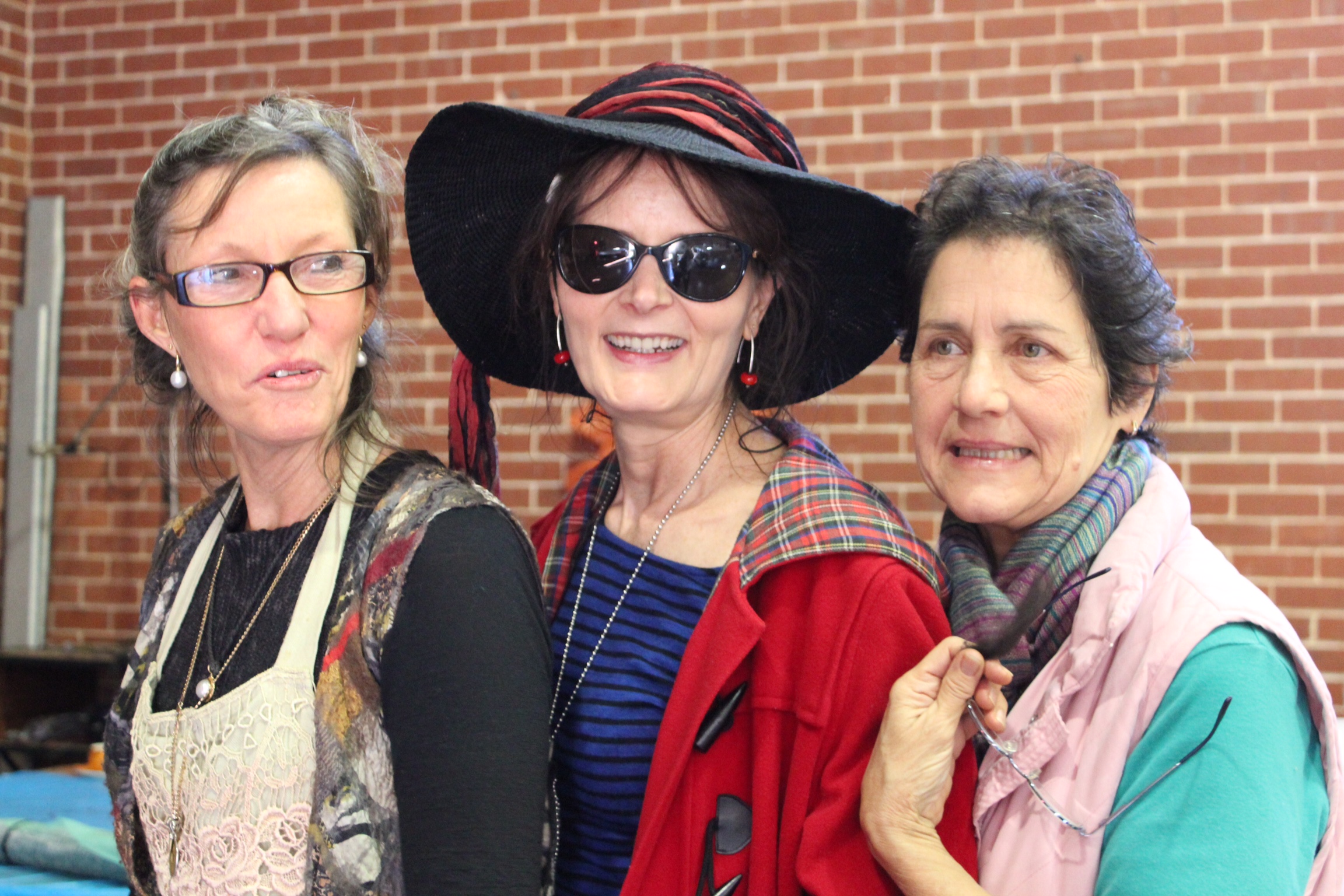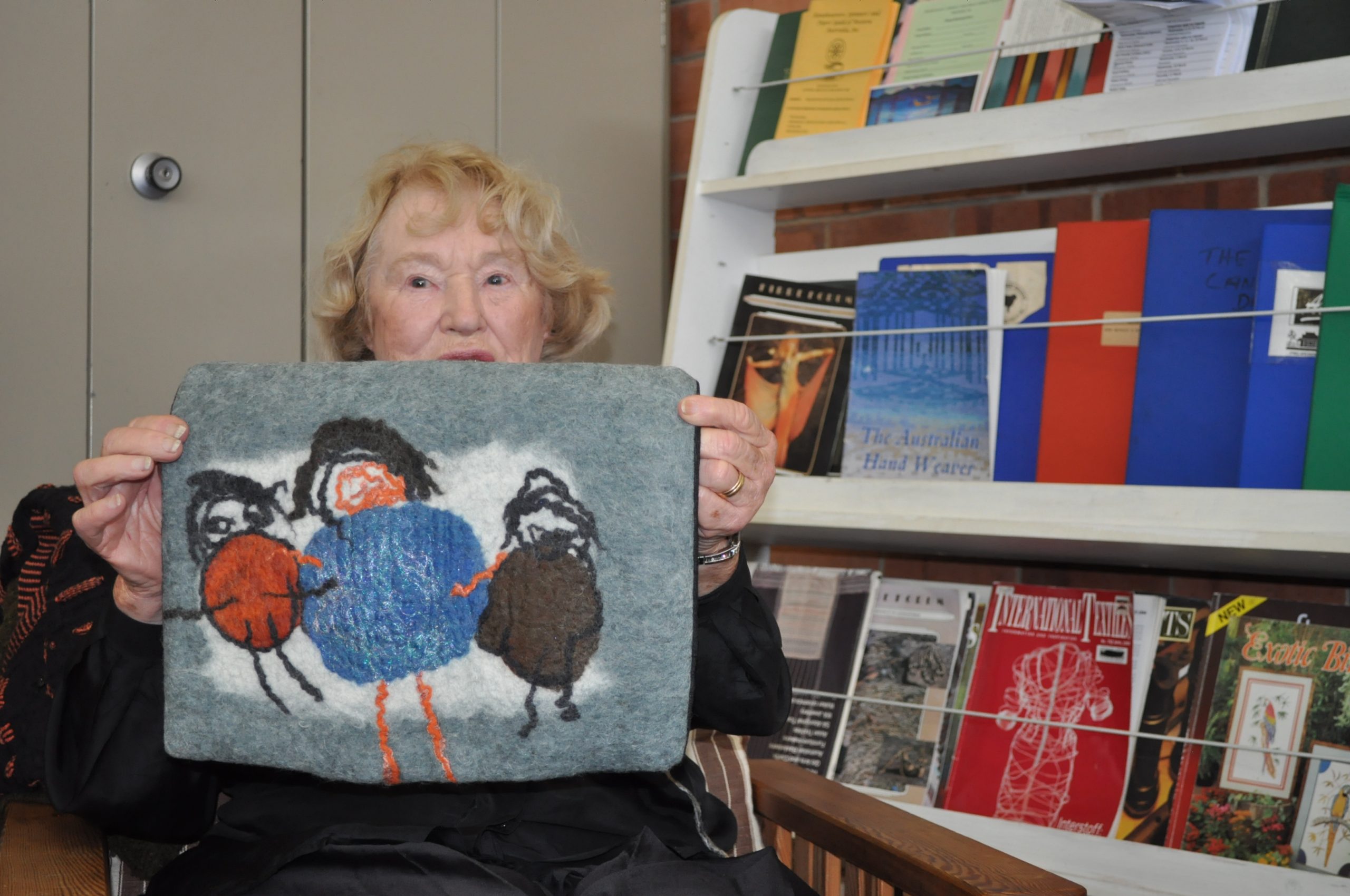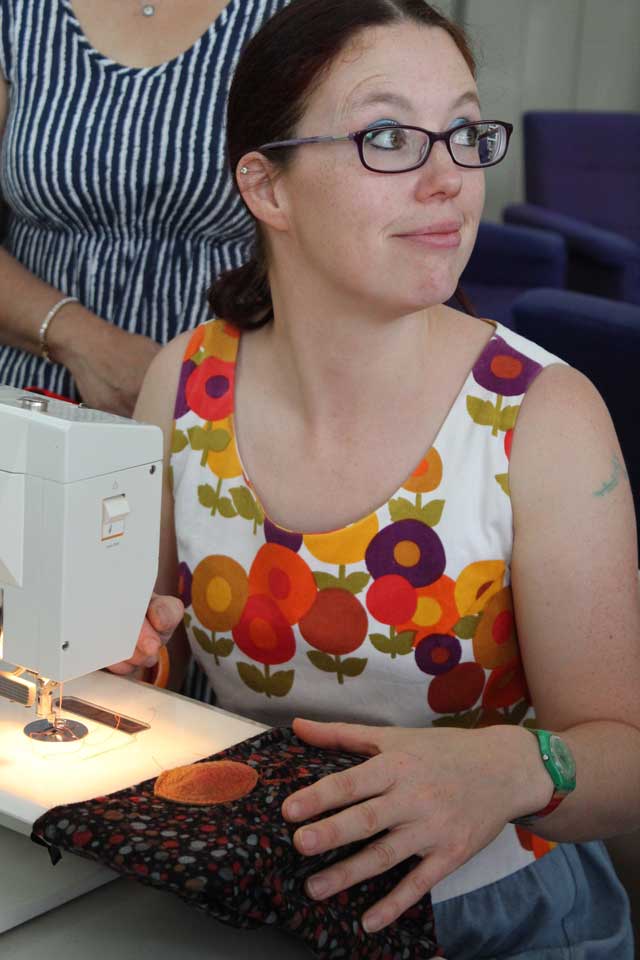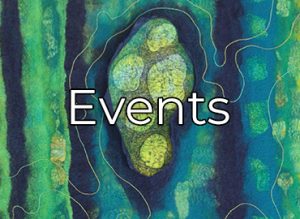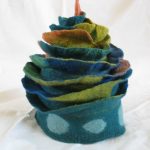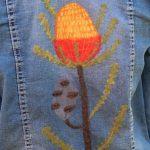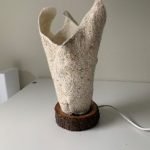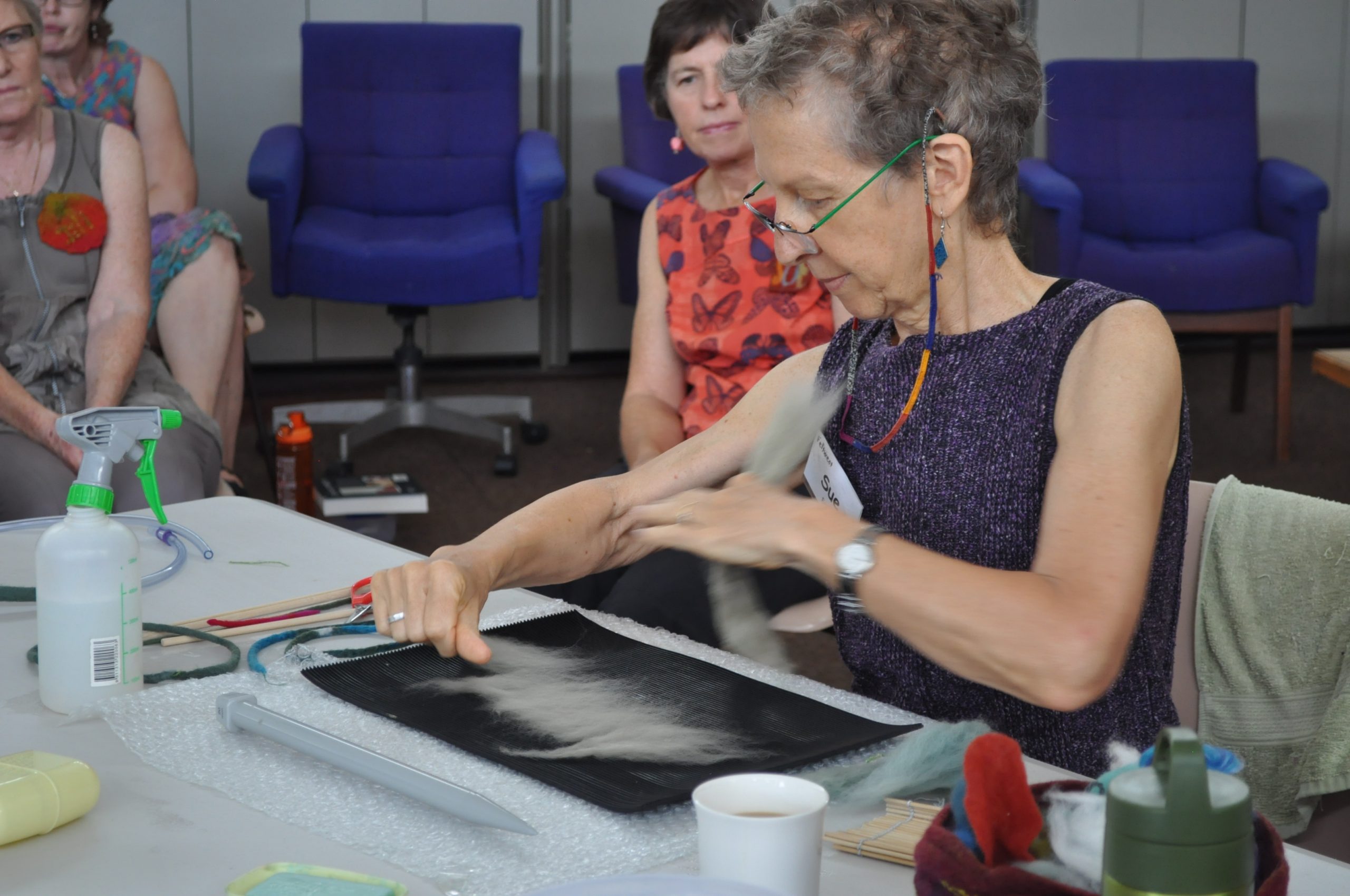
Toss n Tell Meeting 21 March 2015 and Demonstration by Sue Eslick
Before the formal part of our meeting commenced we watched a very informative demonstration by Sue Eslick on “How to Make Classy Cords”
Sue started the demonstration by laying out on bubble wrap 2 layers of wool in crosshatch pattern (ie one layer of wool laid on the diagonal then covered by a second layer of wool laid on the opposite diagonal). She suggested laying a minimum of 2 layers – more layers if you want a thicker cord. She then sprayed it with soapy water (but not too soapy). She laid a very thin length of string the length of the laid out wool, with a little bit of the string protruding on each side of the length of the laid wool . She also placed wooden kebab sticks along the length of the laid out wool. These sticks very slightly overlapped where the sticks joined each other to achieve the length of the laid out wool, and protruded slightly at each end of the laid wool. She then pulled the bubble wrap up to cause the wool to roll over, then gently with her fingers rolled it in one direction (not backwards and forwards – just one direction).


She cautioned against making the roll too tight initially as it makes it very difficult to remove the wooden sticks, which you need to do after a short time if you want to make a solid cord. She pulled the kebab sticks out where they were protruding from the ends of the roll and then made a small cut in the roll at the point the kebab sticks were overlapping in the middle and removed the middle stick(s). After removing the sticks she kept rolling.
Sue noted that if you lean on the cord while you are rolling it, it will stretch and become longer and thinner. So at this point you need to think how long and then you want it! After it had become very firm from the rolling, Sue put it in a shushi mat and rolled it more. She said this helps it to become felted more quickly. She recommended also rolling on a ribbed rubber mat purchased from Clark Rubber as this too can help speed up the felting process. She suggested that if you notice it is becoming hairy as you roll it, you need to add more soap and water.
When she wanted to join the 2 ends of the cord together Sue first tied together the 2 ends of the thin string protruding from each end of the cord, covered the tie with a small amount of wool, then rubbed and rolled the join until it felted together. She noted that if you want to make a very long cord it is easier to make the cord in sections and then join those sections together (in the way described above), rather than trying to roll one very long tube all at once.





While kebab sticks can be suitable to assist in making thinner cords, different thicknesses of cord can be achieved by using other objects to roll the cord around initially. It depends on how thick you want the cord to be: knitting needles, foam tubes from Bunnings, hollow tubing from Clark Rubber can all be useful! Different effects can be achieved by commencing laying wool and rolling it around a wide tube and then transferring the cord to a narrower tube. Or you can continue to roll the cord on the wide tube, then remove the tube. The hollow cord can then be cut up to make hollow beads. You can create a cord with a concertina texture by commencing to lay the cord around a thick knitting needle, rolling it, then transferring the wool tube to cover a narrower foam tube and in the process, pushing the wool tube together and letting it dry scrunched up on the narrower tube. Sue showed us a number of different effects which can be achieved in using these different resists. The concertina texture cord idea, for example, makes a very interesting necklace.
We were very delighted to learn these special techniques and tricks which will help us when wanting to create a good looking, well felted cord. Many thanks to Sue for sharing her skills and experiences in this interesting demonstration.
President Sue Harrington opened the meeting with several announcements of exciting forthcoming FeltWest events including the fact that bookings were open to register for our annual Retreat at Muresk 28 May – 31 May 2015. Members were advised that they need to first log onto our website to enable them to get through to the relevant section of the website to register. The early bird price for the full retreat is $340 and includes all lunches, dinners and 2 trestle tables, as well as lots of felting fun and camaraderie.
Sue expressed our grateful thanks to Jennifer Blair and Liz Odd for their generous and continuing work over many years in creating the raffle prize awarded at each Toss n Tell meeting to a lucky winner. She advised that in future there will be 2 raffles drawn in a year – at the AGM in August and at the Christmas lunch in November. You still need to take a raffle ticket when you pay $2 at the beginning of a Toss n Tell meeting but be sure to legibly write your name on the ticket stubb and keep your ticket because these are the tickets from which the super raffles will be drawn at the August and November meetings.


Sue also again invited all members interested in teaching beginners’ workshops to apply to do so by sending a short summary of their teaching and felting experience to our workshop co ordinator, Sue Eslick.
FeltWest again has a stall at the Craft and Quilt Fair held at the Perth Convention Centre 20 – 24 May 2015. Mary Ann Dawson, Chris Gray and Alison Gomes are co ordinating the stall. A roster for members to work on the stall on morning or afternoon shifts has been drawn up but there are still a number of spare places which need to be filled and we are looking for more volunteers to add to the roster. Please contact Chris, Mary Ann, or Alison if you are able to help. Working on a morning or afternoon shift on the stall entitles the volunteer to free entry to the Fair for the day!
Sue expressed our great appreciation to Antoinette Boyd for her continuing inspiration, hard work, and dedication of time in the creation of our much enjoyed, wonderful magazine, Retrospective.

Sue Eslick spoke about the forthcoming felted bag workshop which she will be teaching over 1 ½ days on Saturday 4th and the morning of Sunday 5th July 2015 at Craft House. The cost will be $75. She brought along to the meeting a gorgeous moss green (in texture and colour) felted bag to show us an example of what participants will be able to make at the workshop.
Christiane Gray opened our Library this morning and brought along three beautifully decorated felted necklaces she had made. Unfortunately she had to leave to go to work before the Toss n Tell part of the meeting commenced but we did manage to get some photos of them before she left.
Ai Lin showed us a beautiful red felted flower she had made for Remembrance Day and a very fine wool and silk brown and purple wrap. She said she had pulled the silk lap so finely in the course of laying the piece that she had lost the texture of the silk lap but the silk sheen was still very evident and the wrap draped beautifully.

Liz Odd had also made a finely felted, beautifully draping wrap, laying a fine layer of grey wool on an attractive animal print silk fabric length.
Helen Climas discussed her initial difficulty when making her crescent shaped thin grey and white nuno felted scarf. She had used a waterproof pen to mark out the crescent shape but found after laying out the piece that the colour of the pen’s ink had transferred onto the fabric. This she resolved by pushing the ink to the edges of the piece, with a very pleasing final result.
Jeanette Humphries showed us her fitted and very fashionable bright pink and orange sleeveless silk lap felted dress. She said she achieved the effect by cross hatching wool strips over a pulled silk lap stretched over a resist. She added silk hankies where the silk lap couldn’t be sufficiently stretched far enough and said she was fortunate to find a light slip in bright pink to wear under the dress!
Sara Quail displayed her very attractive orange felted bag with long cord shoulder strap. She said it was made of Corriedale wool of 4 layers decorated with silk ribbon.


Juliet Hargreaves had made exquisite large dramatic green and teal felted sculptures and grey and white felted sculptures featuring separate contrasting wool layers opening up at the front of the sculptures, attached to each other at the back, and decorated with small felted beads.
In conclusion, Sue Harrington shared with us her felted beach rock from New Zealand. Alison Gomes won the raffle!
